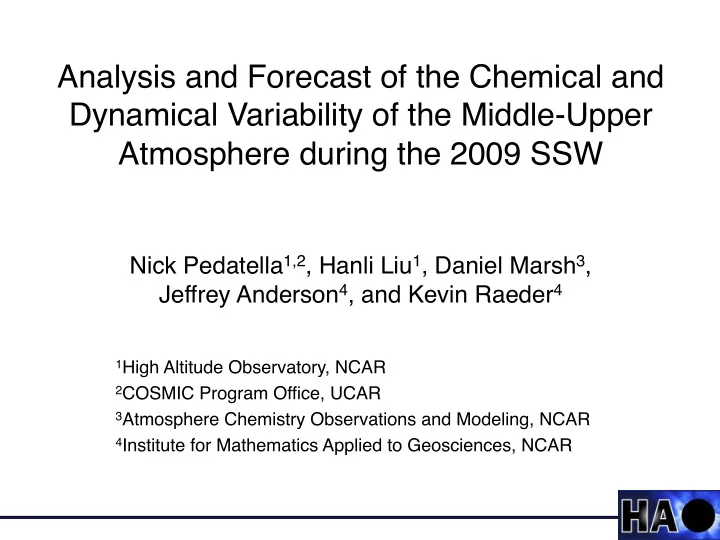

Analysis and Forecast of the Chemical and Dynamical Variability of the Middle-Upper Atmosphere during the 2009 SSW Nick Pedatella 1,2 , Hanli Liu 1 , Daniel Marsh 3 , Jeffrey Anderson 4 , and Kevin Raeder 4 1 High Altitude Observatory, NCAR 2 COSMIC Program Office, UCAR 3 Atmosphere Chemistry Observations and Modeling, NCAR 4 Institute for Mathematics Applied to Geosciences, NCAR
Motivation: “Nudging” towards reanalysis can lead to large differences at higher altitudes due to the sensitivity of the mesosphere to GW drag Zonal Mean Temperature 70-80 N Constrained Domain (Pedatella et al., 2014)
Differences in modeled MLT dynamics influence nitric oxide descent NO at 80 N, SD-WACCM Nudged Region NO at 80 N, NOGAPS-WACCM Nudged Region (Funke et al., 2017) Direct assimilation of lower, middle, and upper atmosphere observations is one approach to improving simulations of MLT dynamics (Siskind et al., 2015)
Whole Atmosphere Community Climate Model eXtended (WACCMX) - WACCMX is built on top of the Whole Atmosphere Community Climate Model (WACCM), which is the “high-top” atmosphere model component of the Community Earth System Model (CESM) - Finite volume dynamical core (1.9º x 2.5º resolution) - 126 vertical levels (surface to 4.4 x 10 -10 hPa) - Gravity waves parameterized for orographic and nonorographic sources. - Comprehensive interactive chemistry package (MOZART) WACCMX - Solar variability (long term & impulsive) WACCM - Latest version includes self-consistent ionosphere- thermosphere with electrodynamics - WACCMX enables study of middle-upper atmosphere variability due to both the lower atmosphere and solar/geomagnetic activity. - Data assimilation in WACCMX is implemented using the Data Assimilation Research Testbed (DART) ensemble Kalman filter
WACCMX+DART Framework for WACCMX+DART is identical to WACCM+DART (next slide) Same observations are assimilated in the troposphere, stratosphere, and mesosphere. Main change between WACCMX+DART and WACCM+DART is increased damping in WACCMX. This was necessary for model stability, and to ensure that mixing from small scale waves introduced by the data assimilation do not excessively reduce thermosphere O/N 2 and electron density. Changes made for model stability do have a slight negative impact on performance of the data assimilation in the troposphere-stratosphere. Troposphere humidity is biased by ~20-30% due to model physics issue when using a 5 min time-step. We have performed initial WACCMX+DART analysis and forecast simulations for the 2009 SSW time period.
WACCM+DART 500 hPa Geopotential Height WACCM+DART provides an atmospheric reanalysis from the 0000 UT 15 Nov., 2008 surface to the lower thermosphere (~145 km). NCEP Reanalysis Conventional Lower Atmosphere Observations: Aircraft temperature and wind Radiosonde temperature and wind Satellite drift winds COSMIC GPS refractivity Sparse Middle/Upper Atmosphere Observations: WACCM+DART TIMED/SABER Temperature (100 - 5 × 10 -4 hPa) Aura MLS Temperature (260 - 1 × 10 -3 hPa) Typically use a 40-member ensemble, which is a tradeoff between computational expense and having a sufficiently large ensemble to capture a variety of atmospheric states. WACCM+DART is useful for correcting model biases, studying dynamical variability due to sudden stratosphere warmings, and short-term tidal variability Pedatella, N. M., K. Raeder, J. L. Anderson, and H.-L. Liu (2014), Ensemble data assimilation in the Whole Atmosphere Community Climate Model, J. Geophys. Res., 119 , doi: 10.1002/2014JD021776.
Middle Atmosphere Variability in WACCMX+DART and SD-WACCMX (Pedatella et al., 2014) SD-WACCMX : Specified Dynamics WACCMX constrained to MERRA meteorology up to 50km
NO descent following the SSW (Funke et al., 2017)
Stratosphere ozone variability ≈√ ≈√ SABER Observation
Diurnal Migrating Tide (Pedatella et al., 2014)
Semidiurnal Migrating Tide (Pedatella et al., 2014)
Comparison with Juliusruh MF Radar 100 (b) Juliusruh Juliusruh Radar V (88 km, 54N, 13E) 50 0 -50 WACCMX NAVGEM RADAR r = 0.55 -100 2 4 6 8 10 12 14 Day 200912 Tides are too weak in WACCMX+DART due to damping (McCormack et al., 2017)
Agreement with radar observations is better in WACCM+DART 100 Juliusruh Radar V (88 km, 54N, 13E) (b) Juliusruh 50 0 -50 WACCM NAVGEM RADAR r = 0.55 -100 2 4 6 8 10 12 14 Day 200912
2009 SSW Forecast Experiments - Initialize 40-member ensemble forecasts (hindcasts) of the 2009 SSW on January 5, 10, 15, 20, and 25. - Ocean SSTs are specified as the true values (i.e., not forecasted) - Solar activity is specified by using 27-days prior solar activity
2009 SSW Forecasts: Lower-Middle Atmosphere Temperature
2009 SSW Forecasts: Lower-Middle Atmosphere Zonal Wind
2009 SSW Forecasts: 60º N, 10 hPa Zonal Wind
2009 SSW Forecasts: 60º N, 0.01 hPa Zonal Wind
2009 SSW Forecasts: Upper Stratosphere Ozone
2009 SSW Forecasts: Diurnal Migrating Tide Forecasts run with default damping
2009 SSW Forecasts: Diurnal Migrating Tide Forecasts run with modified damping
2009 SSW Forecasts: Solar+Lunar Semidiurnal Migrating Tide
2009 SSW Forecasts: TEC at 75W
Summary Recent developments in WACCMX support whole atmosphere data assimilation, providing a global view of the troposphere, stratosphere, mesosphere, thermosphere, and ionosphere state Middle atmosphere chemical and dynamical variability are generally well reproduced in WACCMX+DART. Tidal amplitudes are generally too weak in WACCMX+DART, indicating the need to determine a better method for filtering small-scale waves introduced by DA. Ionosphere variability during the 2009 SSW is reproduced in WACCMX+DART. Forecast experiments for 2009 SSW show that middle-upper atmosphere variability can be qualitatively predicted ~5-10 days in advance of the SSW. Have completed WACCMX+DART analysis for 2009-2010, and 30 day forecast experiments initialized on the 1 st and 15 th of each month are in progress. Results will be made available on the Earth System Grid (www.earthsystemgrid.org) when finished. Tentatively planning (within the next few years) WACCM+DART reanalysis for 2004-present
Recommend
More recommend